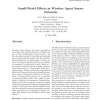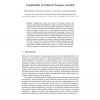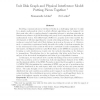23 search results - page 3 / 5 » On the Hardness of Optimization in Power Law Graphs |
STOC
2004
ACM
13 years 10 months ago
2004
ACM
Several peer-to-peer networks are based upon randomized graph topologies that permit efficient greedy routing, e.g., randomized hypercubes, randomized Chord, skip-graphs and const...
SPAA
2010
ACM
13 years 4 months ago
2010
ACM
We develop logarithmic approximation algorithms for extremely general formulations of multiprocessor multiinterval offline task scheduling to minimize power usage. Here each proce...
IJWMC
2010
13 years 1 months ago
2010
Coverage, fault tolerance and power consumption constraints make optimal placement of mobile sensors or other mobile agents a hard problem. We have developed a model for describin...
WABI
2007
Springer
13 years 10 months ago
2007
Springer
Graph-theoretic models have come to the forefront as some of the most powerful and practical methods for sequence assembly. Simultaneously, the computational hardness of the underl...
IPPS
2009
IEEE
13 years 11 months ago
2009
IEEE
Modeling communications in wireless networks is a challenging task since it asks for a simple mathematical object on which efficient algorithms can be designed, but that must also...



